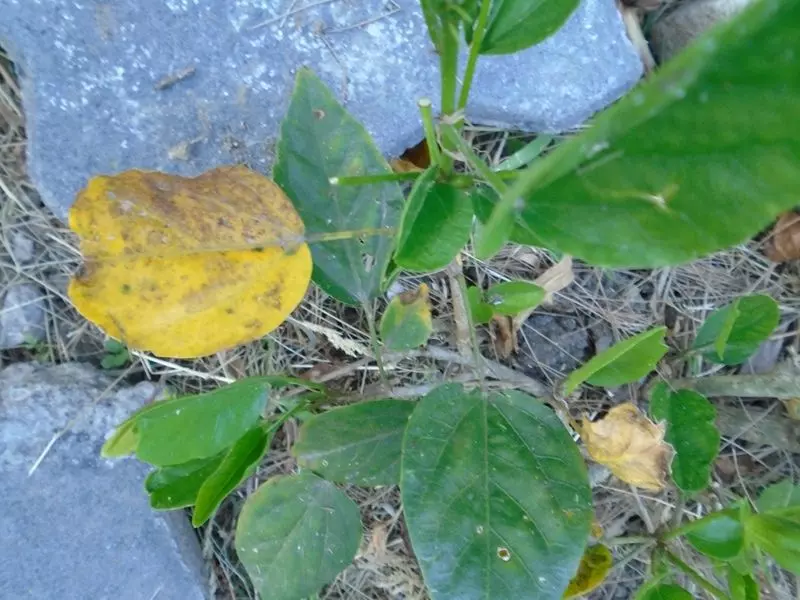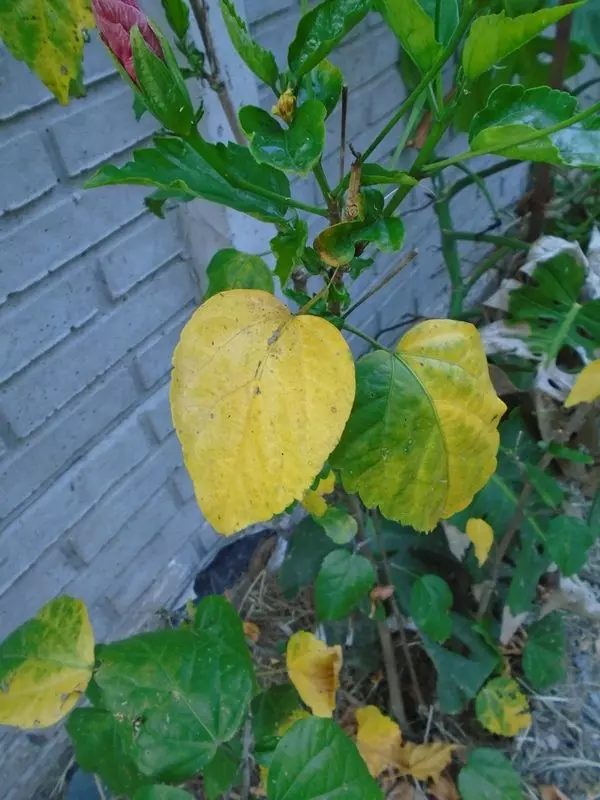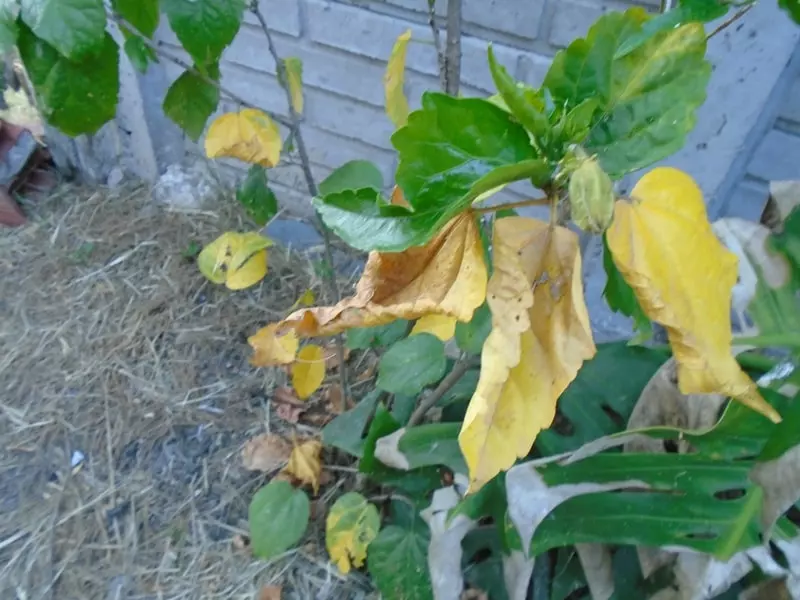“My hibiscus has yellow leaves” or “Rose of Sharon leaves turning yellow“. These are frequent queries we receive and in this article, you will find the information to avoid this problem ever again. If you came to this article, it is because you saw yellow leaves on your hibiscus, isn’t it? First of all, you should not worry or be alarmed, there is always time to fix the problem of yellow leaves on Hibiscus.
Few flowering shrubs offer such a spectacular bloom as the hibiscus, also called the Rose of Sharon, scientifically known as Hibiscus syriacus. In fact, its cultivation is widespread in many countries, so much so that it is considered the national flower of South Korea (and the country is even compared to the flower).
Among all flowering shrubs, Hibiscus requires soils with medium to slightly higher fertility, with deep soils that retain moisture well (tendency to clay soils).
For the best nutrient assimilation, a slightly acid pH (pH between 5-6.5) is recommended, but it can grow in alkaline soils (pH > 7.5) as long as attention is paid to the possible lack of microelements that are difficult to absorb at this pH (such as iron, zinc or manganese).
Check out our recommended article to learn how to measure the soil pH.
These care tips, such as proper soil, fertilization, and pH are important to review when understanding the causes of Hibiscus yellow leaves.
Table of Contents
What Causes Yellow Leaves on Hibiscus?
“My hibiscus has yellow leaves” or “Rose of Sharon leaves turning yellow” Throughout this article, we will discuss all the causes that cause your hibiscus to have yellow leaves. You will learn how to fix each problem and see how to control and keep your hibiscus healthy.
What Causes Yellow Leaves on Hibiscus? We must keep in mind that having some yellow leaves is not a bad thing, since old leaves should fall off the plant, but when we see too many yellow leaves on our hibiscus that is a problem.
There are several reasons why a hibiscus may have yellow leaves, that is why in this article we will explain how to identify the problem causing yellow leaves and how to solve it.
Yellow Leaves on Hibiscus Due to Lack of Light
Hibiscus Yellow Leaves Due to Lack of Light. Hibiscus is generally not a very light-demanding plant, but it is also not a plant that grows well in shade.
We all know that plants need sunlight for photosynthesis to develop properly. Hibiscus leaves turning yellow can be caused due to a lack of light.
Without sunlight, photosynthesis will not take place properly and the leaves will begin to fall, the solution is to place the hibiscus in an area that receives at least 8 hours of light daily.

Nutrient Deficiency in Hibiscus
Treatment for yellow leaves on hibiscus – Nutrient Deficiency in Hibiscus. The yellow leaves on hibiscus can be caused by a lack of nutrients, we will notice it because the leaf will remain on the plant, but it will not fall off so easily.
We can solve the lack of nutrients by fertilizing with a suitable fertilizer for our plants, we can also add some new soil to improve its nutrients.
Fertilize the hibiscus and wait a month to see the changes because over-fertilizing is also detrimental to our plant.
We recommend you these fertilizers for your hibiscus (Dr. Earth), (Hibiscus Plant Food), or (Nelson Plant Food).

Hibiscus Yellow Leaves Due to Excess Water
Hibiscus Yellow Leaves Due to Excess Water. Prolonged exposure to wet soil can cause stress to a hibiscus plant, resulting in wilting or drooping leaves and a loss of color, turning to a lighter green or yellow-green.
To remedy this, it is recommended to remove the plant from its pot and let it drain before repotting. Overwatering can also lead to brown spots on the leaves, as a result of rot caused by excess moisture around the roots.
If your hibiscus is in the ground, I recommend you stop watering immediately and check if it is possible to change some of the substrates to one with better drainage. You can also improve drainage by applying perlite, compost, or a bit of shredded dried leaves to the soil.
Hibiscus Yellow Leaves Due to Lack of Water
On the other hand, if the hibiscus does not receive enough water, it will drop its leaves to avoid transpiration and conserve water. However, before they drop, the leaves turn yellow. If the soil is dry and the plant has yellow leaves, make a good watering schedule.
The important thing is to maintain a balance in the watering of the hibiscus, you can use a soil moisture meter for the soil or simply insert a wooden stick and observe when you take it out if the soil remains stuck. If it sticks it means that it has good humidity, if it comes out dry it means that it needs a little water.
Location Causing Hibiscus Yellow Leaves
Cold drafts often cause Hibiscus leaves to turn yellow and drop. If your plant is near an air conditioner in summer or a drafty window in winter, move it to a place without drafts.
On the other hand, if your hibiscus is outdoors make sure it is located in a sunny spot so it can receive good lighting. You can plant it near a fence so that it receives less wind.
Remember that the ideal temperature for hibiscus is between 55 and 75 °F (13 and 21°C). It does not tolerate the cold and does not survive frost.
Viral Infection on Hibiscus May Cause Yellow Leaves
Hibiscus’s yellow leaves may be caused by a viral infection, yellow spots may appear on the leaves throughout the plant. Deformed leaves and stems may appear, also discolored flowers may appear in a plant disease by a virus.
You can treat your plants with a systemic fungicide or discard them. Remember that many of these diseases can be transmitted to other plants. Pruning diseased hibiscus branches is very good for treating diseases. Learn more about when to prune hibiscus for winter.

Yellow Leaves on Hibiscus in Florida
Several Florida readers wrote to us inquiring about yellow leaves on Florida hibiscus. The causes of these yellow leaves may be due to what has already been mentioned in this article, but I should also clarify that it may be due to where you live in Florida.
The University of Florida mentions in their article that in South Florida the hibiscus stays green all year round due to the southern climate. On the other hand, in North Florida hibiscus will lose their leaves due to the climate of that region which is much colder than South Florida.
That is why if you notice yellow leaves on your hibiscus during the fall season, and you live in North Florida, you should not worry because it is a natural process. However, check that the yellow leaves of the hibiscus are not due to other causes such as those I have mentioned in this article.
Final Conclusions
As you have seen, there are several reasons why hibiscus has yellow leaves. Evaluate your hibiscus with this article and decide on the right treatment. By identifying the problem causing yellow leaves on hibiscus in time, you will be able to cure your hibiscus plant quickly and save it from dying.
Here are more articles about Hibiscus (Rose of Sharon) that we believe you will find useful to learn all about Hibiscus care and how to prune Hibiscus to promote flowering the following year.



